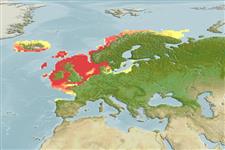Environment: milieu / climate zone / depth range / distribution range
Ecología
marino demersal; oceanodromo (Ref. 51243); rango de profundidad 10 - 200 m, usually 10 - 150 m (Ref. 35388). Temperate; 72°N - 43°N, 26°W - 45°E (Ref. 54592)
Northeast Atlantic: Bay of Biscay to the White Sea and off Iceland.
Length at first maturity / Tamaño / Peso / Age
Maturity: Lm 29.3, range 20 - 30 cm
Max length : 65.0 cm TL macho / no sexado; (Ref. 9988); peso máximo publicado: 3.0 kg (Ref. 6112); edad máxima reportada: 23 años (Ref. 6112)
Small head and mouth. Body is oval. Skin is marbled and smooth. Lateral line almost straight, slight curve above the pectoral fin (Ref. 35388).
Lives most often on stony bottoms. Feeds on a variety of small invertebrates, but polychaetes seem to dominate. Apparently they do not feed in wintertime (Ref. 9900). Marketed fresh and frozen; eaten steamed, fried, broiled, microwaved and baked (Ref. 9988).
Spawning is mainly confined to depths of 55-91 m in the northwestern North Sea and commences at a minimum temperature of 6.5 °C in Scottish waters. Sex ratio is about 1:1, but females progressively predominate upon sexual maturity.
Vinnikov, K.A., R.C. Thomson and T.A. Munroe, 2018. Revised classification of the righteye flounders (Teleostei: Pleuronectidae) based on multilocus phylogeny with complete taxon sampling. Molecular phylogenetics and evolution, 125:147-162. (Ref. 122998)
IUCN Red List Status (Ref. 130435)
Threat to humans
Harmless
Human uses
Pesquerías: comercial; Acuario: Acuarios públicos
Más información
ReferenciasAcuiculturaPerfil de acuiculturaRazasGenéticaElectrophoresesheritabilidadEnfermedadesProcesamientoNutrientsMass conversion
Herramientas
Special reports
Download XML
Fuentes de Internet
Estimates based on models
Preferred temperature (Ref.
123201): 7.1 - 12.5, mean 9.9 °C (based on 1310 cells).
Phylogenetic diversity index (Ref.
82804): PD
50 = 0.5625 [Uniqueness, from 0.5 = low to 2.0 = high].
Bayesian length-weight: a=0.00759 (0.00603 - 0.00954), b=3.09 (3.02 - 3.16), in cm total length, based on LWR estimates for this species (Ref.
93245).
Nivel trófico (Ref.
69278): 3.2 ±0.33 se; based on food items.
Resiliencia (Ref.
120179): Medio, población duplicada en un tiempo mínimo de 1.4-4.4 años (K=0.08-0.42; tm=3-6; tmax=23).
Prior r = 0.71, 95% CL = 0.45 - 1.14, Based on 1 stock assessment.
Fishing Vulnerability (Ref.
59153): High vulnerability (57 of 100).
Climate Vulnerability (Ref.
125649): Low to moderate vulnerability (29 of 100).
Nutrients (Ref.
124155): Calcium = 20.4 [11.3, 39.5] mg/100g; Iron = 0.237 [0.134, 0.434] mg/100g; Protein = 17 [15, 19] %; Omega3 = 0.301 [0.150, 0.610] g/100g; Selenium = 18.1 [9.7, 37.5] μg/100g; VitaminA = 7.6 [1.8, 30.7] μg/100g; Zinc = 0.377 [0.264, 0.576] mg/100g (wet weight);
